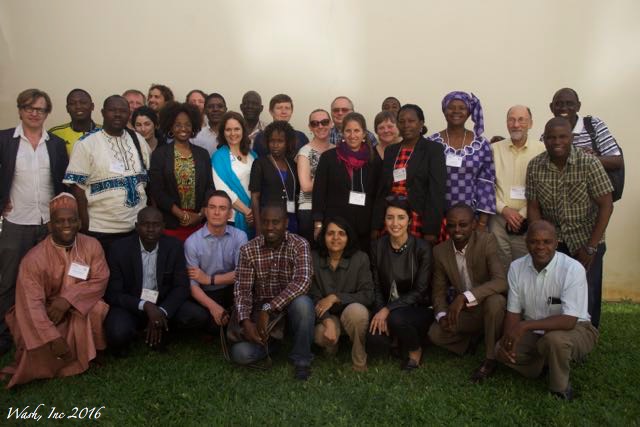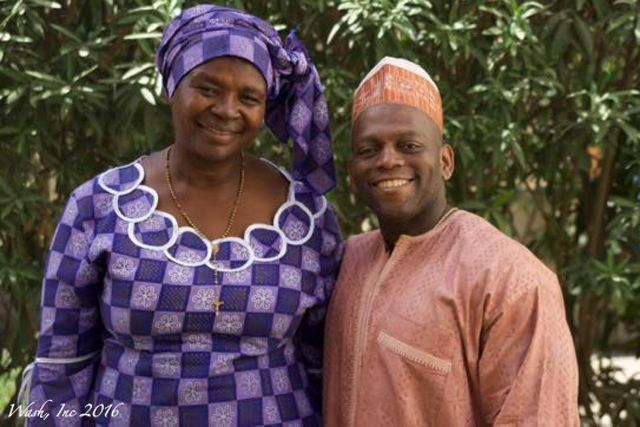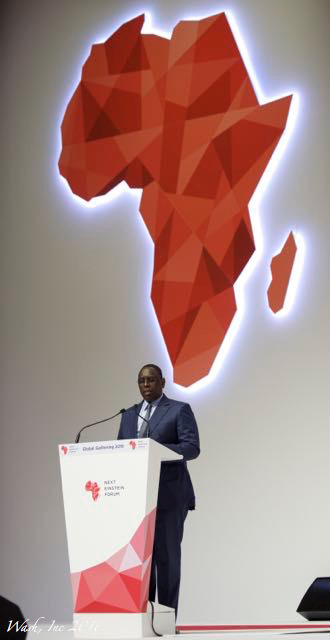
A Decade of Disease Modeling in Africa
[April, 2016] The March 2016 workshop on “Modeling of
Infectious Diseases with a Focus on Ebola” was the tenth
workshop that DIMACS has organized and held in Africa over nearly a
decade of engagement with researchers in Africa. The workshop was
held in Senegal,  close to the areas of West Africa hardest
hit by the 2014 Ebola outbreak but itself largely untouched by
Ebola. The workshop examined how mathematical models can be used to
understand and forecast disease spread, as well as how they can help
to evaluate the effect of different interventions on epidemiological
outcomes.
close to the areas of West Africa hardest
hit by the 2014 Ebola outbreak but itself largely untouched by
Ebola. The workshop examined how mathematical models can be used to
understand and forecast disease spread, as well as how they can help
to evaluate the effect of different interventions on epidemiological
outcomes.
Accelerated urbanization in the developing world concentrates
population and creates conditions that are ideal for increased rates
of disease transmission. Combining this with the interconnectedness
afforded by improved transportation, increasing migration, tourism,
and global trade, infectious diseases emerge and re-emerge more
frequently, spread greater distances, and evolve into new and more
virulent strains. All of these factors accentuate the need for a
prompt and well-informed response to an emerging outbreak.
 Mathematical models played an important role in the response to the
2014 Ebola outbreak. As the emergency progressed, researchers
developed mathematical models of Ebola’s epidemiological dynamics to
help improve understanding of its transmissibility and of the
potential effectiveness of various interventions that had been or
could be implemented in West Africa. Dr. Michael Washington, a
participant in the workshop and a Health Systems Specialist with the
Centers for Disease Control and Prevention (CDC), noted that models
brought the need for intervention in West Africa into sharp
focus. He said, “our largest and most influential modeling results,
which were used by the CDC Director Thomas Frieden, were our
mathematical model showing the impact of what would happen if we did
nothing to stop this outbreak. These results also showed the outcome
of delaying the international response, and how we could stop this
outbreak if 70 percent of Ebola cases could be placed in Ebola
treatment units, had effective isolation, and had safe
burials. This message resonated throughout the public health
community and it guided actions of the CDC, United States
Government, WHO, and many other partners.”
Mathematical models played an important role in the response to the
2014 Ebola outbreak. As the emergency progressed, researchers
developed mathematical models of Ebola’s epidemiological dynamics to
help improve understanding of its transmissibility and of the
potential effectiveness of various interventions that had been or
could be implemented in West Africa. Dr. Michael Washington, a
participant in the workshop and a Health Systems Specialist with the
Centers for Disease Control and Prevention (CDC), noted that models
brought the need for intervention in West Africa into sharp
focus. He said, “our largest and most influential modeling results,
which were used by the CDC Director Thomas Frieden, were our
mathematical model showing the impact of what would happen if we did
nothing to stop this outbreak. These results also showed the outcome
of delaying the international response, and how we could stop this
outbreak if 70 percent of Ebola cases could be placed in Ebola
treatment units, had effective isolation, and had safe
burials. This message resonated throughout the public health
community and it guided actions of the CDC, United States
Government, WHO, and many other partners.”
These studies provided valuable insights on the spread of Ebola in
different communities by helping to quantify the differential
contribution of safe funeral practices, placement into treatment
facilities, limiting social contact, and increasing awareness of the
presence of infection within a community. About model predictions
for Liberia and Sierra Leone, Washington said, “Not only did our
model show what could and should happen, it actually showed what did
happen.” A CDC
video on modeling for decision making in public health, which
was played at the workshop, begins with remarks by Frieden expanding
on those of Washington about the role of mathematical models during
the Ebola outbreak.
 The Senegal workshop brought together a group of 30
international participants with interdisciplinary interests spanning
mathematics, ecology, epidemiology and public health to review
lessons learned from the most recent Ebola outbreak and explore how
to enhance preparedness for emerging threats such as Zika.
Included in the workshop were government officials from agencies
such as the CDC as well as researchers who were heavily involved in
managing the Ebola epidemic. Participants in past DIMACS
programs—the DIMACS
Initiative on Modeling of Infectious Diseases of Africa and
the DIMACS/MBI
US-African Biomathematics Initiative—were also well
represented and included African researchers who had visited DIMACS,
as well as US graduate students and faculty who had visited Africa
through DIMACS programs.
The Senegal workshop brought together a group of 30
international participants with interdisciplinary interests spanning
mathematics, ecology, epidemiology and public health to review
lessons learned from the most recent Ebola outbreak and explore how
to enhance preparedness for emerging threats such as Zika.
Included in the workshop were government officials from agencies
such as the CDC as well as researchers who were heavily involved in
managing the Ebola epidemic. Participants in past DIMACS
programs—the DIMACS
Initiative on Modeling of Infectious Diseases of Africa and
the DIMACS/MBI
US-African Biomathematics Initiative—were also well
represented and included African researchers who had visited DIMACS,
as well as US graduate students and faculty who had visited Africa
through DIMACS programs.
The workshop was organized by Fred Roberts, Director Emeritus of
DIMACS, at the request of the National Science Foundation, as a
satellite to the Next Einstein
Forum (NEF) Global Gathering, an international event
highlighting science and education in Africa, hosted by
Senegal president Macky Sall.
Most of the workshop participants also attended the NEF Gathering,
whose participants included some 1000 invited dignitaries. Among
them were prominent scientists, policymakers, and business leaders
from around the world, including two African heads of state, NSF
Director France Córdova, and science and education ministers from
around Africa and other parts of the world. Association of the
workshop with the Next Einstein Forum raised the prominence of the
topic of infectious disease modeling and highlighted successes that
have come from prior funding by NSF of programs in Africa. Two of
the workshop participants, Abba Gumel (Arizona State) and Alpha
Amadou Sall (Institut Pasteur de Dakar), were among the presenters
at the NEF Global Gathering.
Building partnerships between US and African researchers is an
important goal of DIMACS programs in Africa. Toward this end, the
workshop was preceded by a one-day
mini-symposium, also on the topic of modeling infectious
diseases and Ebola, held at the University Cheikh anta Diop of Dakar
and co-organized with faculty at the university. Michael Washington,
who was participating in his sixth DIMACS workshop in Africa, said,
“The DIMACS program has exposed many African and American students
to how mathematical, economical, and epidemiological models have
been and can be used to influence policies and decisions. More
importantly, it has helped students to see how they can improve the
situation in Africa with their quantitative skills in the area of
public health, emergency response and preparedness. Because of these
events, I believe more students have decided to pursue careers in
areas that are more focused on helping their community.”
Printable version of this story: [PDF]
Photos courtesy of Michael Washington.
 DIMACS Homepage
DIMACS Homepage
Contacting the
Center

 close to the areas of West Africa hardest
hit by the 2014 Ebola outbreak but itself largely untouched by
Ebola. The workshop examined how mathematical models can be used to
understand and forecast disease spread, as well as how they can help
to evaluate the effect of different interventions on epidemiological
outcomes.
close to the areas of West Africa hardest
hit by the 2014 Ebola outbreak but itself largely untouched by
Ebola. The workshop examined how mathematical models can be used to
understand and forecast disease spread, as well as how they can help
to evaluate the effect of different interventions on epidemiological
outcomes.  Mathematical models played an important role in the response to the
2014 Ebola outbreak. As the emergency progressed, researchers
developed mathematical models of Ebola’s epidemiological dynamics to
help improve understanding of its transmissibility and of the
potential effectiveness of various interventions that had been or
could be implemented in West Africa. Dr. Michael Washington, a
participant in the workshop and a Health Systems Specialist with the
Centers for Disease Control and Prevention (CDC), noted that models
brought the need for intervention in West Africa into sharp
focus. He said, “our largest and most influential modeling results,
which were used by the CDC Director Thomas Frieden, were our
mathematical model showing the impact of what would happen if we did
nothing to stop this outbreak. These results also showed the outcome
of delaying the international response, and how we could stop this
outbreak if 70 percent of Ebola cases could be placed in Ebola
treatment units, had effective isolation, and had safe
burials. This message resonated throughout the public health
community and it guided actions of the CDC, United States
Government, WHO, and many other partners.”
Mathematical models played an important role in the response to the
2014 Ebola outbreak. As the emergency progressed, researchers
developed mathematical models of Ebola’s epidemiological dynamics to
help improve understanding of its transmissibility and of the
potential effectiveness of various interventions that had been or
could be implemented in West Africa. Dr. Michael Washington, a
participant in the workshop and a Health Systems Specialist with the
Centers for Disease Control and Prevention (CDC), noted that models
brought the need for intervention in West Africa into sharp
focus. He said, “our largest and most influential modeling results,
which were used by the CDC Director Thomas Frieden, were our
mathematical model showing the impact of what would happen if we did
nothing to stop this outbreak. These results also showed the outcome
of delaying the international response, and how we could stop this
outbreak if 70 percent of Ebola cases could be placed in Ebola
treatment units, had effective isolation, and had safe
burials. This message resonated throughout the public health
community and it guided actions of the CDC, United States
Government, WHO, and many other partners.”  The Senegal workshop brought together a group of 30
international participants with interdisciplinary interests spanning
mathematics, ecology, epidemiology and public health to review
lessons learned from the most recent Ebola outbreak and explore how
to enhance preparedness for emerging threats such as Zika.
Included in the workshop were government officials from agencies
such as the CDC as well as researchers who were heavily involved in
managing the Ebola epidemic. Participants in past DIMACS
programs—the DIMACS
Initiative on Modeling of Infectious Diseases of Africa and
the DIMACS/MBI
US-African Biomathematics Initiative—were also well
represented and included African researchers who had visited DIMACS,
as well as US graduate students and faculty who had visited Africa
through DIMACS programs.
The Senegal workshop brought together a group of 30
international participants with interdisciplinary interests spanning
mathematics, ecology, epidemiology and public health to review
lessons learned from the most recent Ebola outbreak and explore how
to enhance preparedness for emerging threats such as Zika.
Included in the workshop were government officials from agencies
such as the CDC as well as researchers who were heavily involved in
managing the Ebola epidemic. Participants in past DIMACS
programs—the DIMACS
Initiative on Modeling of Infectious Diseases of Africa and
the DIMACS/MBI
US-African Biomathematics Initiative—were also well
represented and included African researchers who had visited DIMACS,
as well as US graduate students and faculty who had visited Africa
through DIMACS programs.